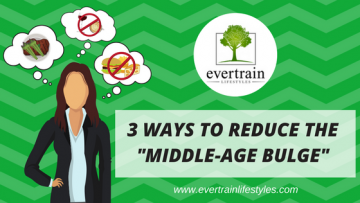3 WAYS TO REDUCE THE “MIDDLE-AGE BULGE”
As health and fitness coaches who work primarily with people over 50, this topic comes up quite frequently in session.
Client A – “How do I get rid of this (as client points to mid-section)?”
The answer to this is never quick and easy. But there are things that are in your control, that can make a difference right away.
There seems to be something that happens to us humans when we reach middle age.
It may seem as though the body takes a bit of a drop off and things change all of a sudden.
You may feel that your clothes are getting tighter.
The weight loss battle becomes more like an uphill battle and the things that worked in the past, just don’t seem to work as well as they used to.
What is the cause of this?
It is safe to say that it is rarely one thing that causes this. Instead we usually see a combination of factors that lead people to this point.
Factors like;
- Lean muscle loss. It is estimated that we lose on average 5lbs of lean mass (the kind of mass we want to keep) for every decade after 25. If you do the math that is 15lbs of lean mass by 55. If our weight were to stay exactly the same, that means we would have increased by 15lbs of fat.
- A decrease in metabolism. On average a 2-4% decrease in resting metabolic rate (RMR) each decade after 25. Although this doesn’t seem like much, it really adds up.
- Overestimating how well we eat/Underestimating our intake of indulgences or foods that generally don’t help us.
- Inactivity/sedentary lifestyles. Never before in history have humans sat down so often (i.e. TV, eating, work, driving, etc.).
- Hormonal changes (i.e. menopause, andropause).
- Inability to train intensely due to growing injury/mobility concerns.
- Medications.
- and more.
Tackling one’s health and fitness goals takes a multi-faceted approach (nutrition, fitness, lifestyle, etc.), but the path to success in anything starts with one step. Below we outline 3 actions you can take today that will help you to reduce “the middle-age bulge”.
1. Eat lean protein and vegetables at every meal (focus on breakfast for even better results).
This is a foundational habit that we teach all of our members. To see change now and in the long run, master the basics first. By eating protein and vegetables at every meal you can see a dramatic change in your waist line.
Here are 2 reasons why you will want to implement this into your daily routine.
- Increased Thermic Effect of Feeding (TEF).
When we ingest food, our digestive system must work to break it down, absorb and assimilate its nutrients. This work has a cost in calories. The amount of calories burned in this process is referred to as the Thermic Effect of Feeding (TEF). In other words, eating itself can increase your metabolism. Protein and vegetables are at the top of the TEF scale. Having protein and vegetables at every meal will help you burn more calories almost immediately.
- Steady blood sugar levels.
Keeping blood sugar levels steady can help to improve insulin sensitivity and help with your overall food quality and quantity throughout the day. Imagine a day of work where you aren’t hungry. You’re not thinking of food and craving the homemade cookies that your co-worker brought to the office this morning. You go into lunch and dinner calm and ready to enjoy a slow paced and relaxed meal (as opposed to scarfing down every last bit on your plate and going for seconds).
Eating lean protein and vegetables at every meal can lead you towards this kind of eating. Not having these at each meal, can potentially keep you hungry through the day, craving foods you know you probably shouldn’t eat and even cause you to overeat without realizing it.
Lean Protein All-Stars;
- Red meat
- poultry
- lean pork cuts
- wild game
- fish/seafood
- eggs
- plant-based proteins (beans, lentils, tofu, etc.)
Non-Starchy Vegetables:
- Leafy greens (spinach, swiss chard)
- carrots
- tomatoes
- zucchini
- broccoli
- bell peppers
- cauliflower
- asparagus
- etc.
BONUS TIP: Have an unconventional breakfast that includes a harder to digest protein and vegetables for even better results. This might be a challenge for most people but will certainly deliver results.
Think this idea is crazy? Try the more conventional option. If you’re ready to challenge yourself and try something new, try taking off “a big chunk”.
- Ready to take off a big chunk:
1-2 palm sized lean steak cut.
1-2 fists of stir fried vegetables or spinach salad
- Something more conventional:
2-3 egg omelette with 1-2 fists of vegetables (spinach, tomatoes, onions, garlic, asparagus, etc.)
(Please note that we have not discussed carbohydrate or healthy fat consumption. This would be a topic for another conversation altogether. At Evertrain we do not necessarily advocate low-carb diets as a long-term solution.)
2. Drink calorie-free drinks.
Although we are not big believers in counting calories as a means to predict weight-loss, it is important to know the basics of calories in vs. calories out.
In other words, if you’re taking in more calories than you are burning you might find it challenging to lose inches around the waist.
What you really want to do is make sure that the calories that you take in are actually helping, not hurting your efforts. If losing inches around your waist is a goal, you want to be eating mostly nutrient dense foods that are lower in calories compared to calorie dense foods that are lower in nutrients.
Most drinks with calories (we’re not referring to smoothies that replace a meal), are low in nutrients and high calories. And more often than not, these calories are not helping your efforts to thin down your waist line.
Do a quick audit of one week’s intake of calorie drinks. It’s not uncommon to see an extra day(or two)’s worth of calories that come from drinks alone.
Making the Move to Calorie Free Drinking
For most people this is a big challenge. So if you’re not ready for this drastic of a change, even small changes can go a long way. It doesn’t have to be all-or-nothing.
For example, if you are used to having 2 large coffees per day with 2 creams and 2 sugars, try a measurable and consistent decrease.
- Aim for 2 mediums per day.
- Aim for 1 cream and 1 sugar.
- Replace sugar with a natural sweetener like stevia.
- Try 1 or 2 days in the week where you drink herbal tea instead.
If you’re really ambitious and want to see big changes, move from calorie drinks to drinks like herbal tea (with nothing added), black coffee, and water.
At the end of the day, the calories we take in from these calorie drinks are not helping us move closer to our goals. If you want to see a reduction in the inches around your waist, this is usually one of the fastest ways to see change.
3. Reduce/eliminate foods that your body doesn’t agree with.
Food allergies, intolerances and gut health problems are extremely common. Symptoms can pop-up in several forms such as; bloating, gas, discomfort, etc. To add to this, by eating foods our body doesn’t agree with we are causing damage to our intestinal tract. With time this will lead to a host of other problems.
Some of the most common food allergies in adults are;
- eggs
- dairy
- tree nuts
- peanuts
- seafood/shellfish
- wheat
- etc.
It can be hard to pinpoint which foods your body disagrees with. The best way to do this is to collect data, analyze and make an outcome based decision.
For example, if you suspect that dairy is causing you to feel gassy, bloated and may be preventing your fat-loss goals, collect some data.
- Take notes of how you feel after eating anything that contains dairy for 3-7 days. Write down anything you think can be related (emotional, physical, mental). You can’t be too detailed.
- Observe what you wrote down.
- Analyze the data you’ve collected (i.e. my digestion is completely off whenever I eat cheese).
- Make an outcome based decision. In other words, based on the objective information you now have, make a conscious decision on what to do next (i.e. reduce my dairy intake to on occasions).
Many of the clients we’ve worked with either didn’t know they had food intolerances or knew and chose to simply not address them. Once we worked on reducing or eliminating their intake of these foods, we noticed a big decrease in inches around the waist.
This was for 2 reasons;
- With improved gut health, they were able to better digest, absorb and assimilate nutrients. This led to losing belly fat.
- They were simply less bloated.
Consistency is the Key
It’s important to know that any change you choose to make, has to be done consistently to have the desired effect. We recommend taking one of these habits and doing it every day for 2-4 weeks. Then once you’ve gotten this down pat, layer on another (just make sure you don’t stop doing the previous one).
Overtime you’ll begin to add new habits that will actually last and become the new norm. If you have any questions about these habits, we’d love to help you out. Please feel free to email us here, or join our free weekly newsletter for more tips on how to live a healthy and fit life after 50.
Committed to Your Success,
The Evertrain Team
Evertrain Lifestyles Inc. is an Ottawa based fitness and nutrition coaching business that specializes in working with people over 50 looking for a long-term solution to their health and fitness goals. Their coaches are passionate about teaching their members about the importance of safe, injury-free exercise and creating habits that will last.










